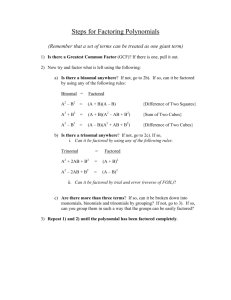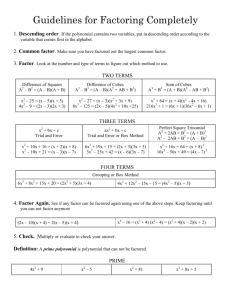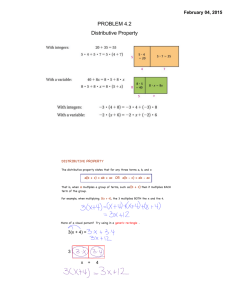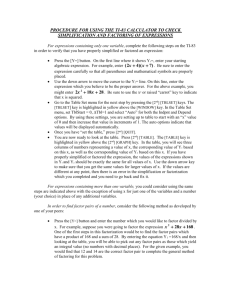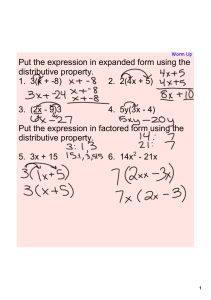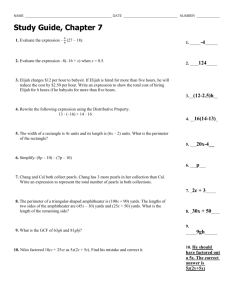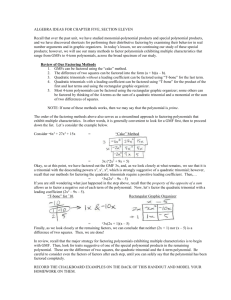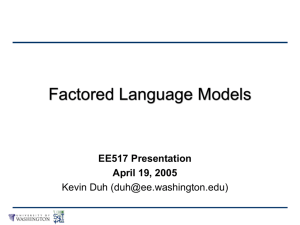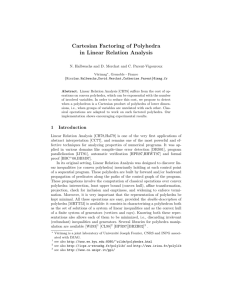Factoring
advertisement
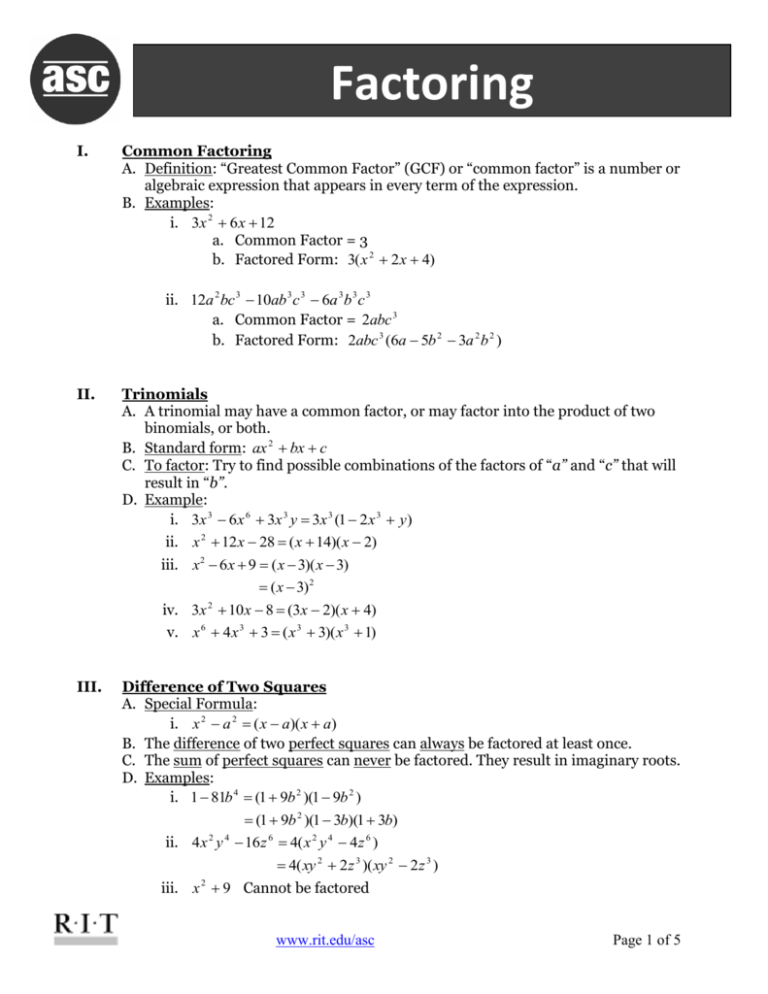
Factoring I. Common Factoring A. Definition: “Greatest Common Factor” (GCF) or “common factor” is a number or algebraic expression that appears in every term of the expression. B. Examples: i. 3x 2 6 x 12 a. Common Factor = 3 b. Factored Form: 3( x 2 2 x 4) ii. 12a 2 bc 3 10ab 3 c 3 6a 3 b 3 c 3 a. Common Factor = 2abc 3 b. Factored Form: 2abc 3 (6a 5b 2 3a 2 b 2 ) II. Trinomials A. A trinomial may have a common factor, or may factor into the product of two binomials, or both. B. Standard form: ax 2 bx c C. To factor: Try to find possible combinations of the factors of “a” and “c” that will result in “b”. D. Example: i. 3x 3 6 x 6 3x 3 y 3x 3 (1 2 x 3 y) ii. x 2 12 x 28 ( x 14)( x 2) iii. x2 6 x 9 ( x 3)( x 3) ( x 3) 2 iv. 3x 2 10 x 8 (3x 2)( x 4) v. x 6 4 x 3 3 ( x 3 3)( x 3 1) III. Difference of Two Squares A. Special Formula: i. x 2 a 2 ( x a)( x a) B. The difference of two perfect squares can always be factored at least once. C. The sum of perfect squares can never be factored. They result in imaginary roots. D. Examples: i. 1 81b 4 (1 9b 2 )(1 9b 2 ) (1 9b 2 )(1 3b)(1 3b) ii. 4 x 2 y 4 16 z 6 4( x 2 y 4 4 z 6 ) 4( xy 2 2 z 3 )( xy 2 2 z 3 ) iii. x 2 9 Cannot be factored www.rit.edu/asc Page 1 of 5 www.rit.edu/asc Page 2 of 5 IV. Sum & Difference of Two Cubes A. Special Formulas: i. x 3 a 3 ( x a)( x 2 ax a 2 ) ii. x 3 a 3 ( x a)( x 2 ax a 2 ) B. Hint for factoring: i. The sign between “x” and “a” in the first factor of the product will be the same sign as the sign between the two cubes. The sign between “ x 2 ” and “ax” in the second factor will be the opposite sign. C. Examples: Same Opposite i. x 3 8 x 3 2 3 ( x 2)( x 2 2 x 4) ii. x 3 27 x 3 33 ( x 3)( x 2 3x 9) iii. a 3 8b 3 a 3 (2b) 3 ( x 2b)(a 2 2ab 4b 2 ) iv. 27 x 3 64 y 3 z 6 (3x) 3 (4 yz 2 ) 3 (3x 4 yz 2 )(9 x 2 12 xyz 2 16 y 2 z 4 ) V. Factoring by Grouping A. Method: Arrange the four terms in two groups of two terms each. Choose any two terms that have a common factor as a group. B. Remove any common factor from each group. C. Remove the common factor from the two terms that result in step 2. D. Warning: Not all expressions can be factored by grouping. In fact, some polynomials cannot be factored by any method. E. Step-by-Step: i. ab b ac c ii. b(a 1) c(a 1) iii. (a 1)(b c) 1. Two groups of two terms 2. Remove common factors 3. Remove resulting common factors F. Examples: i. 3ax 2ay 3bx 2by 3x(a b) 3 y(a b) (3x 3 y)(a b) ii. 6 x3 y 4 xy 3 12 yx 2 8 y3 4 y3 ( x 2) 6 yx 2 ( x 2) (6 yx 2 4 y 3 )( x 2) www.rit.edu/asc Page 3 of 5 VI. FACTOR COMPLETELY – Some problems may require more than one factoring step. 1. x 2 5x 24 2. x 2 5 xy 24 y 12. x 2 4 2 13. 3x 2 12 3. 8c 3 d 3 e 3 4c 2 d 4 e 6c 2 e 5 14. 2 x 8 y 2 y 4. 7 xy 2 14 x 2 y 3 21x 4 y 3 15. 24a 4 8a 2 80 5. x 2 9 16. 10a 3 25a 2 6. 6 x 2 8x 8 17. 4c 2 1 7. 30 x 3 y 40 x 2 y 40 xy 18. 16e 2 15m 6 8. x 4 81 19. 9 x 4 y 4 1 9. x 2 3x 18 20. 81x 4 y 4 1 10. 5x 2 11x 4 21. 64 x 3 y 6 11. t 3 27 22. z 6 125 www.rit.edu/asc Page 4 of 5 Factoring: Answers 1. ( x 8)( x 3) 12. Cannot be factored. 2. ( x 8 y)( x 3 y) 13. 3( x 2 4) 3. 2c 2 e(4cd 3 e 2 2d 4 3e 4 ) 14. 2 y( x 4 1)( x 2 1)( x 1)( x 1) 4. 7 xy 2 (1 2 xy 3x 3 y) 15. 8(3a 2 5)(a 2 2) 5. ( x 3)( x 3) 16. 5a 2 (2a 5) 6. 2(3x 2)( x 2) 17. (2c 1)(2c 1) 7. 10 xy (3x 2)( x 2) 18. Cannot be factored. 8. ( x 3)( x 3)( x 2 9) 19. (3x 2 y 2 1)(3x 2 y 2 1) 9. ( x 3)( x 6) 20. (9 x 2 y 2 1)(3x 2 y 2 1)(3x 2 y 2 1) 10. Cannot be factored. 21. (4 x y 3 )( x 2 4 xy 3 y 6 ) 11. (t 3)(t 2 3t 9) 22. ( z 3 5)( z 2 5z 25) www.rit.edu/asc Page 5 of 5

